The front plate on this camera says it is an AGFA B2 Commander, which is a folding camera from the 1940s that takes 120 roll film and uses scale focus. Beyond that, I have struggled to find more information about this little camera online. What little I can find is that this is a very rare variant of another camera called the AGFA B2 Speedex. It would appear that the only difference is cosmetic as this model has more chrome than the Speedex.
Film Type: 120
Lens: 85mm f/4.5 AGFA Anastigmat 3 elements
Focus: 3.5′ to Infinity
Type: Scale Focus
Shutter: Leaf
Speeds: T, B, 1/2 – 1/250 seconds
Exposure Meter: None
Battery: None
Flash Mount: None
Manual: (This is for a model that’s very similar) http://www.cameramanuals.org/agfa_ansco/ansco_speedex_jr.pdf
History
One of the things that makes collecting old cameras enjoyable, is digging into the history of each camera. The more I learn about a particular model’s history and what significance it might have held, the more interesting it is for me. Surprisingly, I have had quite a bit of luck finding information about most of the cameras I own. This particular camera has eluded me of all but the most basic info. I found one post from a guy on Photo.net who has this exact model, and he actually posted several nice pictures of the camera and his results with it, but other than this one post and a couple very brief sentences on other sites, I cannot find any conclusive information about this camera. I attempted to contact the author of the post on photo.net, but as of this writing, he has not responded.
The history of this camera is clouded in a relatively confusing history between the two companies that made it. AGFA was a German company founded in 1867 originally called Aktiengesellschaft für Anilinfabrikation. In their early years, AGFA made dyes and other stains for industrial use. By 1894, the company continued to grow and expanded to photographic chemicals and film.
AGFA continued to make film and other film related products throughout the early parts of the 20th century but in 1925, AGFA would merge with the German chemical company IG Farben, and that same year would acquire Rietzschel Camera Works from Bayer who was also part of IG Farben (yes, Bayer the Aspirin company). A year later, AGFA/Rietzschel released its first camera, the Standard. By 1927, the name Rietzschel was retired, and in 1928, AGFA acquired the American company ANSCO.
ANSCO was founded in 1842 (possibly 1841) as E. Anthony & Co. by Edward Anthony as a gallery for daguerreotypes which was a very early form of photography. The company made photography supplies and in 1852, Edward partnered with his brother Henry and the name changed to E. & H.T. Anthony Co. In 1870, the first Anthony camera was made.
Looking to expand their business, the Anthony brothers merged with the Scovill Manufacturing Co based out of Waterbury, Connecticut in 1901 and their name changed once again to Anthony & Scovill, which was abbreviated as ANSCO. The company relocated to Binghamton, New York and officially adopted the name ANSCO in 1907.
Over the next couple of years, ANSCO would become one of the leading manufacturers of film and photographic chemicals, but an ongoing patent lawsuit with Eastman Kodak kept them from taking over the market. While ANSCO would eventually win their case against Eastman Kodak, the settlement they would receive would pale in comparison to the legal costs and lost revenue to the company.
In 1924, ANSCO released their first camera, the Automatic ANSCO, and in 1928 the company was bought by the German company AGFA (some sources say they merged, but its not 100% clear who was the controlling interest).
After 1928, the two companies operated under the name AGFA-ANSCO and would begin a partnership of releasing nearly identical cameras under both names. Many of the cameras sold in the United States were copies of existing AGFA models, but actually made in the USA.
This is where a lot of the confusion comes with the history on some of these cameras as some were released simultaneously in Germany and the US, whereas others were released at different times with slight changes between the two models. World War II made the history of these companies even more confusing.
In the years leading up to World War II, the AGFA-ANSCO business grew rapidly, but in 1941, the US Government would seize assets of the American arm of the company due to its ties with Germany, who was considered an enemy at the time. The US side of the company was merged with the American company GAF (which stands for General Aniline & Film) based out of New Jersey and the company’s operations were overseen by the US Department of Treasury.
The American arm of AGFA-ANSCO-GAF (whatever you want to call them) continued to manufacture film equipment, but stopped camera production in favor of sextants, range finders, and other optical equipment for the war effort. During the war, all products were sold and marketed under the name ANSCO in order to distance themselves from their German ties. After the end of the war, the US Government continued to control the operations of ANSCO as enemy property up until the early 1960s before letting it run as a private company again.
Meanwhile, over in Germany, AGFA continued operations during the war, most likely to produce equipment for the German side of the war. Once the war was over, the Allies would break up the IG Farben company who owned AGFA and create several small companies. In late 1945, AGFA would reappear as a standalone company in East Germany and they would resume making film and cameras.
In 1945, both ANSCO-GAF and AGFA would resume their partnership selling and making cameras. This partnership would last for several more years, but eventually disintegrate in the 1960s. ANSCO would release 9 new models, 7 of which were based off pre-war cameras, and two would be all new designs. AGFA continued to innovate and released several new models of camera over the next decade. In 1952, AGFA would become AGFA AG and become a wholly owned subsidiary of Bayer.
It’s very possible that some (or even all) of the info I’ve presented here is inaccurate, but this is what I was able to conclude based on my research. I warned you that it was confusing! So, with all of that background out of the way, here is what I know about my particular camera.
In 1940, a camera was released in the United States called the AGFA/ANSCO B2 Speedex. The name ‘B2’ is what AGFA/ANSCO called 120 roll film at the time. Although this was a German designed camera, it was made in the United States under the ANSCO brand. In Germany, the camera was sold as the Isolette (early copies were spelled Jsolette or even Jsorette) which was released in 1936 or 1937.
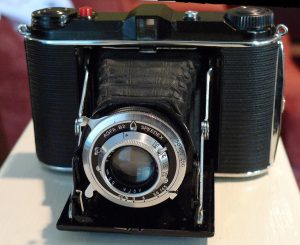
Although I cannot find any specifications of a model called the B2 Commander, my camera shares with the Speedex/Isolette a similar top plate made out of plastic with a single viewfinder window, and dual winding knobs. The pre-war German Isolette cameras had slightly different winding/rewinding knobs, but otherwise look very similar. The pre-war ANSCO B2 Speedex looks almost identical to the B2 Commander, except the top plate and both winding knobs are made from black plastic and the shutter release button is red plastic. The B2 Commander has a champagne colored top plate, chrome winding knobs, and chrome shutter release button. The B2 Commander also has a unique pebbled leatherette covering as opposed to a textured cloth covering of the regular B2 Speedex. One last difference is the front lens plate is all chrome as opposed to black metal on the Speedex. Based on pictures I have found online, these cosmetic changes are the only differences between a B2 Speedex and a B2 Commander.
In 1945, when both ANSCO and AGFA resumed making cameras, all Isolette models featured an accessory shoe, and the new ANSCO Speedex Junior and 4.5 Specials clearly did not feature the name AGFA anywhere on the camera. These models would continue to separately evolve, adding a rangefinder and more advanced lenses, but this design of camera would eventually be discontinued around 1960.
As I mentioned earlier, I have not been able to find a lot of information about the B2 Commander that I own, but the front door of the camera is clearly labeled with an AGFA logo, the lens assembly has the name AGFA, and the back of the camera says it was made in Binghamton, NY by AGFA/ANSCO. The B2 Commander also looks nearly identical to the B2 Speedex which was released in 1940, so that leads me to believe my camera was made in either 1940 or 1941 since ANSCO stopped using the AGFA name during and after the war.
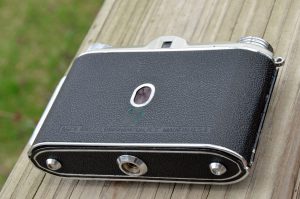
After the US Government relinquished control over ANSCO in the early 60s to its parent company GAF, the ANSCO name would continue to be used on film and camera products until the late 1970s, eventually selling the ANSCO trademark, and dropping out of the consumer photographic market altogether. In the late 80s and early 90s, the ANSCO name would reappear on a line of cheap cameras made by a company out of Hong Kong who bought the rights to the name. GAF would continue on as an industrial manufacturer, most known for a line of roofing shingles, but the 21st Century has not been kind as financial struggles have caused them to move in an out of bankruptcy.
AGFA would fare much better after the war. Although they would exit the camera business in 1983, they would continue to market and sell film and other photography related items well into the 90s. In the early days of digital photography, the AGFA name would be used on a line of Agfa ePhoto cameras sold in Germany. The company still exists to this day, making products for a variety of industries, but none that the average consumer would ever see.
So far this post is more about the history of AGFA and ANSCO, but for me that’s where the most interesting history is. Since there really isn’t a lot of info about the B2 Commander, there’s not as much to say about it, but its a relic from an interesting period of American history where technology was freely shared with Nazi controlled Germany.
Today, AGFA/ANSCO folding cameras are still respected models. While they don’t fetch high prices on the used market, their simple design, small size, and excellent optics make them cheap entry points into medium format photography. These days, if you want to shoot 120 film relatively cheaply, you either find a TLR or a camera like this. TLRs typically go for a bit higher because the models that are popular like Rolleicords, and the Yashica 124G have a unique design that appeals to collectors.
My Thoughts
Prior to owning this camera, I already had two other cameras that took 120 film, but they were both large cameras. I had been looking for a small folding camera, and while I wasn’t necessarily looking for this particular camera, I found this for cheap and it looked to be in excellent condition, so I bought it. I didn’t realize what I had until I received it and started doing research on what exactly the B2 Commander was. Now that I know I have a pretty rare camera in excellent condition, Im definitely more excited than when it first arrived.
When I received the camera, it looked like the shutter was not working, as I could not get the shutter to fire, but after taking a look at the manual, these cameras have double exposure protection which prevents the shutter from firing if it doesn’t think you’ve advanced the film. This can be defeated by re-cocking the shutter a second time and then attempting to fire the shutter. After firing the shutter for the first time, I noticed that 1 second and 1/2 second seemed to be off, but every speed faster than that seemed accurate to the ear. Since I intend to use this camera mostly outdoors, this doesn’t bother me.
The camera was in good shape and the leather showed no signs of holes, but the lens was pretty cloudy. This is a 3 element lens and came apart pretty easily. Thankfully, the haze came off easily. There weren’t any deep scratches or fungus anywhere on any of the elements. It is clear that whoever owned this camera before me, took good care of it.
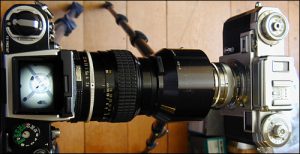
Because I disassembled the lens, this was the first camera in which I had to learn how to collimate the lens. Collimating a lens is the process of measuring and correctly setting the focus to infinity. Any time you disassemble a lens, even if you pay attention exactly to where everything was, there is a chance that slight variations in where the lenses are seated could cause your focus to be off.
It sounds difficult, but its actually a pretty simple process. All you need to collimate a lens is another camera that you know has accurate focus, tape, a marker, and a bright light source. It helps if your focusing camera has a long tele lens, but its not a requirement. I used my Nikon D7000 DSLR with a 18-200mm lens, some plain Jane scotch tape, a black sharpie, and a flashlight.
- Open the back of the camera and put a piece of tape across the film plane where the film would be if the camera was loaded. You want to get the tape as flat as possible, so make sure its pulled taught against the edges of the body of the camera.
- Once you have the tape in position, take your marker and make an “X” as close to the center of the lens as possible.
- Leave the back of the collimating camera open and position both cameras on a flat surface with the lenses pointed at each other. You want to try to get the centerline of each lens as close to level as possible, so depending in the height of your focusing and collimating cameras, you might need to put something under one of the cameras to make the centerlines of the lenses as close as possible. The distance between the two cameras is not super important as infinity is infinity no matter how far away you are, but you obviously want to be relatively close so its easier to see.
- Set the collimating camera’s lens to what you think is infinity, and set your focusing camera’s lens to infinity, and if that camera has an auto focus mode, turn it off.
- The next step depends on whether your collimating camera has both a T and B mode, or just a B mode. T mode is when one press of the shutter release opens the shutter, and it stays open until you press the shutter release a second time to close it, and B mode is where you have to hold down the shutter release to keep the shutter open. Thankfully, the B2 Commander has a T mode, but if it didn’t, you could also do this with B mode, you just need to find a way to keep the shutter open. If you have a shutter release cable with a lock, that would work, or having someone else hold the button down for you helps as well. In either case, use either T or B mode to keep the shutter open.
- Look through the focusing camera’s viewfinder (I set my D7000 to Live View mode so I could use the rear LCD screen) and make fine adjustments to the focusing camera until you see the “X” centered in your viewfinder. If your focus is off on the collimating camera, the X will be out of focus. Do not touch the focus on the focusing camera, but make small changes to the focus wheel on the collimating camera until the X is totally in focus. On the B2 Commander, changing the focus was as simple as rotating the outer wheel. Once I had the X sharply in focus, I reattached the chrome focusing wheel (with the lock on it), and tightened down the two screws holding it in place and that was it.
There is also a video on YouTube where a guy actually shows you what the process looks like in an Isolette. He beats around the bush a bit, so fast forward to around 3:20 into the video to get to where you can see the X.
Keep in mind that collimating only works when both cameras are set to infinity. You cannot do it at any other focal length. I read a technical explanation explaining why, but its not important, just trust me, you need to do this at infinity. Also, as I mention in step 3, the distance between the two cameras is not important, but you want them to be relatively close together.
Once I had the lens cleaned, and the focus collimated, the only other problem I noticed with my camera were several very small hairline cracks in the plastic top of the camera, but nothing that should impact the operation of the camera. It is clear that whoever owned this camera before me, took very good care of it.
Update 10/15/2015
After sitting on my shelf for several months after shooting it in the winter of 2014/15, I took the B2 Commander to a baseball game in early September 2015. At that time, I discovered that the camera had developed an issue with a sticky shutter. About half of the shots were ruined because the shutter stayed open long after the exposure was made.
Its possible that using the camera last winter loosened something up that caused the shutter to stick, or its possible the problem was there all along, but since my first experience with this camera was in cold temps, and the second time was a warm and humid day in late summer, that the warm air caused existing goo to become more sticky. Whichever the reason, I decided to perform a full CLA of this camera.
Disassembling the B2 Commander is surprisingly easy. You could clean the shutter without removing it from the camera, but that would mean exposing the bellows to some chemicals which isn’t the best of ideas. The biggest challenge separating the bellows from a 35mm camera is that it is very difficult to get to the rear lens element within the film compartment. On a 6×6 medium format camera such as this, the opening is much larger and easier to get to.
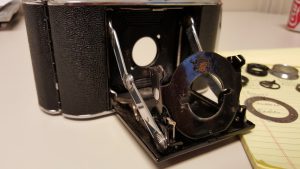
Using a spanner wrench, very carefully loosen the ring around the rear lens element. Once you are able to remove the rear element, the entire bellows will detach from the frame which the shutter and frame are mounted to. Be careful not to damage the bellows. There should be some very thin black metal spacers in between the bellows plate and the plate that the shutter is mounted to. My camera had 3 of them, but its possible that different cameras have a different number. Do not lose these. There is also an inner ring holding the rear glass element to this piece. Using your spanner, you can optionally remove this piece of glass from the ring for cleaning.
To disassemble the shutter, back off the 3 set screws around the edge of the front ring (the metal ring with the focal distances on it). A quarter to a half turn is all thats needed. Do not remove the set screws as they are extremely small and easy to lose.
Once the set screws are backed off, you can lift this ring straight up. Pay very close attention to the orientation of this piece as you will need to put it back on exactly how you took it off. If not, you will need to collimate the lens, which I had planned to do anyway, so I just took it off.
Next you can unscrew the outer lens element. Again, you will need to pay close attention to how many turns you make and the orientation of this lens unless you plan on collimating the lens. There is also an inner ring that holds the physical lens inside of this piece which you can optionally remove for cleaning, but its not necessary.
Remove the 3 screws in the cosmetic name plate and lift off the plate.
Next, the shutter speed ring comes off. There should be some type of notched metal spacer under this, take that off too. Be careful here as the aperture lever can sometimes get in the way. You do not have to remove the aperture lever.
At this point, the shutter can be opened. There are 3 long screws holding the cover of the shutter on. Remove these and gently pry apart the two halves of the shutter. At this point, no other parts of the shutter need to be removed in order to clean it.
The following picture shows everything that has been removed from the camera.
1 – Spacers from behind the rear element and frame.
2 – Front lens element and ring.
3 – Outer front ring with focal distances on it (this is where the set screws are)
4 – Rear ring holding rear glass element and shutter in place
5 – Rear lens element ring along with 3 short screws for #8 and 3 long screws holding #10 and #11 together.
6 – Rear glass element.
7 – Notched spacer in between #9 and #10.
8 – Front chrome nameplate (with aperture scale).
9 – Speed selector ring.
10 – Top cover of shutter.
11 – The rest of the shutter.
At this point, you can pretty much soak the shutter in Ronsonol and clean out all of the old gunk. Clean any gunk off any other pieces, especially the back of #9. AGFA cameras are notorious for “green gunk” that can turn to glue, so even if your B2 Commander wasn’t entirely frozen, chances are, it was tight and this is your best chance to loosen it up and restore it back to new.
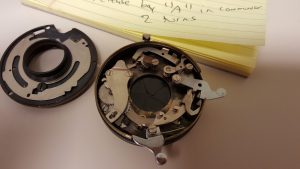
It took me about 3 days of cycling between cleaning and drying the entire shutter before I was happy with it’s operation. Be aware that you cannot properly fire the shutter while it is disassembled. You need to temporarily put #10 back on to fire it at all. If you want to test the different speeds, you need to put #9 on as well. You don’t need to actually screw them in place, simply holding them together with your fingers will do.
After you are satisfied that the shutter is reliably working correctly when its dry, you can put everything back together. There are varying opinions about how to lube a shutter, but in my mind, lube isn’t necessary in a shutter. The pieces should all move properly without any assistance. If any part of the shutter still seems to hand up, or move slowly, then it is not clean yet.
Reassemble the camera in the opposite order you took everything apart. I did struggle a bit screwing the rear lens element back into the shutter. Its a bit of a challenge to get the bellows, plate, rear element, all of the spacer rings, and shutter all in the exact position to screw it down. I found that it was easiest with the door partially closed. The bellows will give you a bit of flexibility, but you must be really careful not the damage the bellows here.
In the days after getting the camera back together, I dry fired it probably a hundred times and not once did it stick or seem slow. I am a little backed up on cameras to shoot, so it may take some time before I have another chance to use this camera, but I am eager to see how the camera performs now. I will update this post once again when I have a chance to shoot with it.
My Results
The B2 Commander does not have any focusing aides like a rangefinder, so everything is done by scale, which means you have to estimate (or actually measure) the distance between the camera and the object you wish to photograph. As I’ve been using old cameras more and more, I am getting better at this.
The easiest way to shoot with a scale focus camera is to start with only things that are really far away. If you are taking pictures of scenery or objects more than 50 feet away, just set your lens to infinity and you’re good to go. When something is closer, you need to get better at judging distances. Remember that in photography, the smaller your aperture (bigger f/stop number), the more “wiggle room” you have with focus. So for example, if you and your object remained in a fixed position, and you took two pictures, one at f/11 and another at f/4.5, more of the picture would be in focus at f/11 than at f/4.5.
If I want to shoot something that’s closer than infinity, I make sure the object is well lit, like in direct sunlight so I can use a smaller aperture to take advantage of the additional area in focus. I also try to picture other “common” distances in my head to help me estimate my distances. I am just short of 6′ tall, so if I want to shoot something that’s 6′ away, I picture myself laying head to toe on the ground. A basketball hoop is 10′ off the ground and an average midsize sedan is 15′ long, so I use those as an aide for distances.
This camera also does not have an exposure meter, so you have to estimate that as well. I’ve mentioned this in some of my other reviews, but for this, use the “Sunny 16” rule.
 Shooting a scale focus camera without any type of exposure metering sounds like an incredibly difficult task for someone used to modern digital photography, but it really is not that hard. I’ve said this before, but film is extremely forgiving. You do not need to get these things perfect for your pictures to still come out great! One of the biggest reasons I love shooting with these old cameras is the fact that you have to think about these things. If I wanted to go out and not have to think, and just press the shutter button in rapid fire succession and get great shots, I’d use my DSLRs. Theres that saying “its all about the journey, not the destination”, which I think applies.
Shooting a scale focus camera without any type of exposure metering sounds like an incredibly difficult task for someone used to modern digital photography, but it really is not that hard. I’ve said this before, but film is extremely forgiving. You do not need to get these things perfect for your pictures to still come out great! One of the biggest reasons I love shooting with these old cameras is the fact that you have to think about these things. If I wanted to go out and not have to think, and just press the shutter button in rapid fire succession and get great shots, I’d use my DSLRs. Theres that saying “its all about the journey, not the destination”, which I think applies.
Once you have a handle on the scale focus and Sunny 16 exposure settings, shooting with this camera is pretty easy. The shutter must be manually cocked, which is done by a small lever on the front, top part of the lens. The focus and aperture rings turn smoothly, like they do on any other camera. You frame your shot using the viewfinder on top of the camera and when you are ready to snap your picture, you press the shutter release button.
A note about firing this camera’s shutter is that the B2 Commander has the quietest shutter of any camera I own. It is so quiet that several times outside, I wasn’t even sure if it fired. Leaf shutters by their very design are pretty quiet, but on my Yashica Electro or my Wards 551 cameras, the leaf shutter is a little more audible. I’m not saying this is a bad thing, in fact, many photographers prefer a quieter shutter, its just something you have to get used to.

My first roll of film through this camera was taken around Christmas 2014 in northern Michigan. While this area of the country provides a picturesque landscape of alpine scenery, its not exactly colorful. In hindsight, I probably would have been better served using some of my black and white Ilford. Instead I chose a roll of Kodak Ektar 100 and ended up with mostly grayscale images.
I can’t fault the camera for my choice in composition, but one thing for certain is that the 85mm triplet lens is razor sharp. You would be forgiven if you thought I was shooting one of the millions of Carl Zeiss or Xenon lenses that were also available around this time. The resolution is incredible. If you look at my gallery above, every shot is razor sharp. The one of the frozen lake is actually a crop showing the houses about half a mile away. It’s also worth noting that the scans on these images were the base level scan from Dwayne’s Photo. Who knows how much more resolution is in the film.
You also might notice that the aspect ratio of all of my shots is 2:3. I cropped every shot from the original 1:1 6cm x 6cm negative that this camera is capable of merely for aesthetic purposes. When I get more experience composing in the square format, I’ll stop cropping them.
This design of camera was popular for quite a few years, even though more capable SLR, TLR, and Rangefinder models existed. The reasons for this is that these cameras are compact, easy to shoot, capable of excellent shots, and inexpensive.
I don’t know how many B2 Commanders were ever made, but from what little I could find, there aren’t many out there, so the odds of you finding one, especially one in good shape are probably pretty small. But even if you can’t find this exact model, I definitely recommend looking for one of the many similar designs out there. They weren’t expensive when they were new, and they’re still not expensive now.
Additional Resources:
http://photo.net/classic-cameras-forum/00ZHWf
http://camerapedia.wikia.com/wiki/Ansco_Speedex
http://blog.jimgrey.net/2012/12/12/ansco-b2-speedex/
http://photosttl.blogspot.com/2010/10/ansco-b2-speedex.html
http://camera-wiki.org/wiki/Ansco_Speedex
http://www.rangefinderforum.com/forums/showthread.php?t=146036


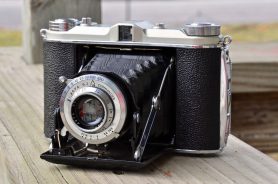

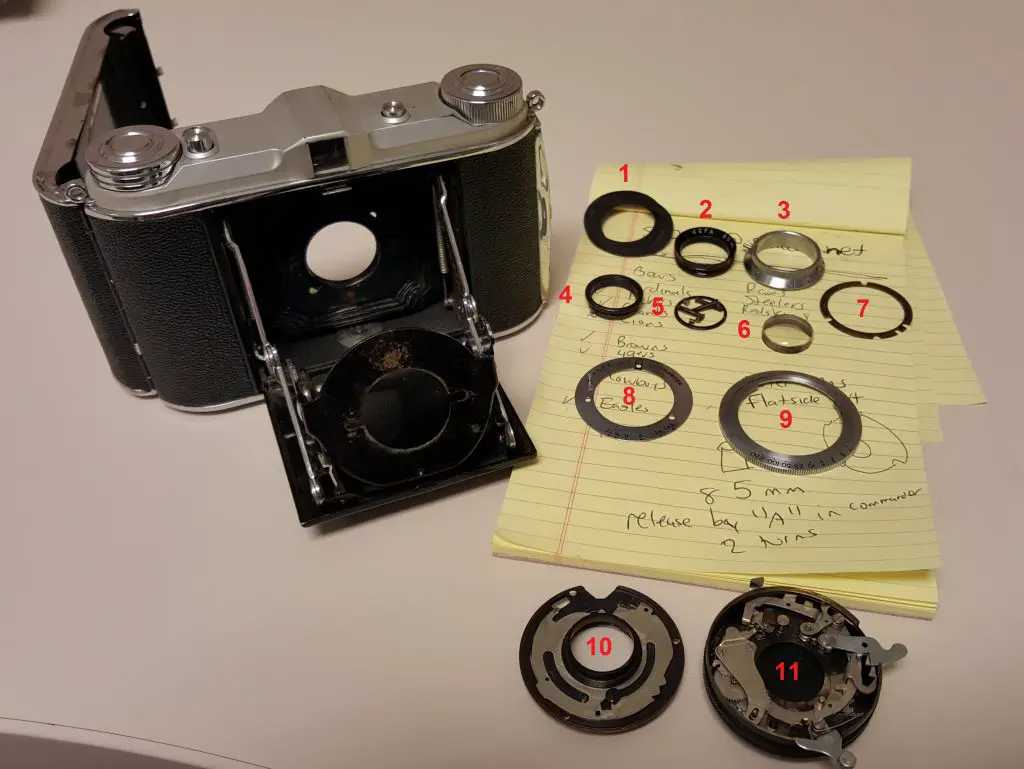









Another outstanding article, again wonderful site and format, incredible information on the cameras we know stand out thabx terry ,,,,,courtenay british columbia
Hi Mike, I found this camera AGFA B2 COMMANDER. Is in almost excellent condition, case is leather and in excellent condition. I also have the instruction booklet inside. The lens comes out when button is pushed and no cloudiness at all on lens. Only problem is that I do not know how to use this and was wondering if you or anybody that was looking for one would like to purchase it. I am not one to be on all these sites and don’t know where to even start to advertise selling it. Any of your expertise is welcomed. Can you please contact me and give me a heads up. I really even would like to have to just hang around the house because it really is a conversational piece and cool looking.
Thanks in advance, Jacquie